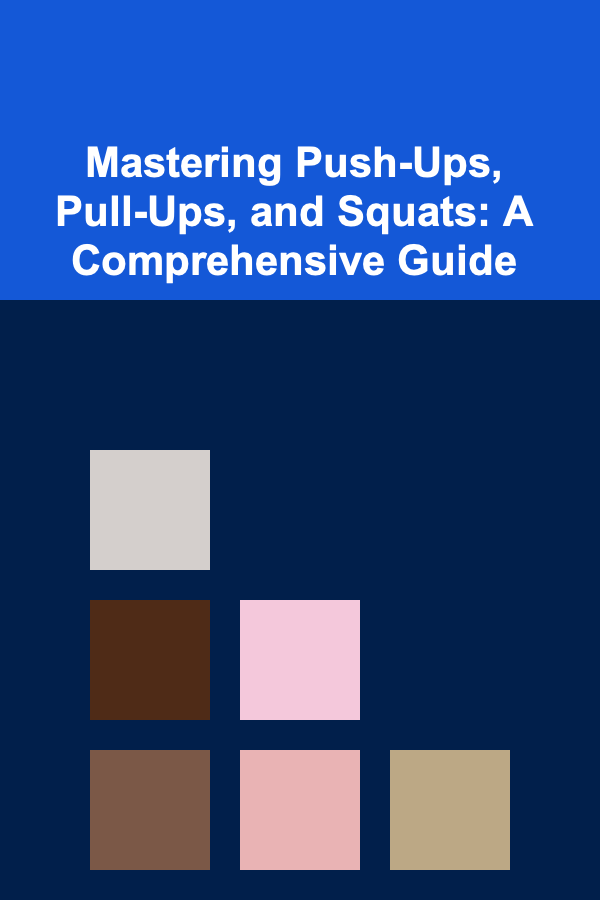
Mastering Push-Ups, Pull-Ups, and Squats: A Comprehensive Guide
ebook include PDF & Audio bundle (Micro Guide)
$12.99$11.99
Limited Time Offer! Order within the next:

Push-ups, pull-ups, and squats are foundational bodyweight exercises. They are incredibly effective for building strength, improving fitness, and enhancing overall well-being. These exercises require no equipment (apart from a bar for pull-ups), making them accessible and convenient. This guide provides an in-depth look at how to master these exercises, covering proper form, progression strategies, common mistakes, and advanced variations.
The Importance of Proper Form
Before diving into progressions and variations, it's crucial to understand and execute each exercise with perfect form. Proper form prevents injuries and ensures that you are targeting the correct muscle groups for maximum benefit.
Push-Up Form: A Step-by-Step Guide
- Starting Position: Begin in a plank position with your hands shoulder-width apart, fingers pointing forward or slightly outward. Your body should form a straight line from head to heels. Engage your core to prevent your hips from sagging or rising.
- Lowering Phase (Eccentric): Slowly lower your body by bending your elbows, keeping them close to your sides (approximately 45-degree angle). Maintain a straight line throughout your body. Lower until your chest nearly touches the ground. It's more important to maintain proper form and go as low as you can while maintaining form, rather than forcing yourself to touch the ground if your form breaks down.
- Pushing Phase (Concentric): Push back up to the starting position by extending your arms. Maintain core engagement and a straight line. Exhale as you push up.
Key Points:
- Core Engagement: Actively engage your core throughout the entire movement. Imagine pulling your belly button towards your spine.
- Body Alignment: Maintain a straight line from head to heels. Avoid sagging hips or a piked position.
- Elbow Position: Keep your elbows close to your body (around 45 degrees) to prevent shoulder injuries. Flaring elbows places excessive stress on the shoulder joint.
- Breathing: Inhale as you lower, exhale as you push up.
Pull-Up Form: A Detailed Breakdown
- Grip: Use an overhand grip (palms facing away from you) slightly wider than shoulder-width apart.
- Starting Position: Hang from the bar with your arms fully extended. Engage your core and retract your scapulae (squeeze your shoulder blades together and down). This "packing" of the shoulders is crucial for shoulder health and power.
- Pulling Phase (Concentric): Pull yourself up towards the bar, focusing on using your back muscles (lats). Imagine pulling with your elbows. Continue pulling until your chin is over the bar. Avoid kipping or using momentum.
- Lowering Phase (Eccentric): Slowly lower yourself back to the starting position with controlled movement. Fully extend your arms at the bottom.
Key Points:
- Scapular Retraction: This is perhaps the most important aspect of a pull-up. Activating your back muscles properly not only increases your pulling power but also protects your shoulder joints.
- Full Range of Motion: Ensure you fully extend your arms at the bottom of each rep and pull high enough for your chin to clear the bar.
- Controlled Movement: Avoid swinging or using momentum to complete the exercise. Focus on using your back muscles to pull yourself up.
- Grip Strength: Grip strength can often be a limiting factor. Work on grip-specific exercises if needed (e.g., dead hangs, farmers walks).
Squat Form: Perfecting the Movement
- Starting Position: Stand with your feet shoulder-width apart, toes pointing slightly outward. Keep your chest up and your core engaged.
- Descending Phase (Eccentric): Initiate the movement by hinging at your hips, as if you are sitting down into a chair. Keep your back straight and your core engaged. Lower yourself until your thighs are parallel to the ground (or as low as your mobility allows while maintaining proper form).
- Ascending Phase (Concentric): Push through your heels to return to the starting position, squeezing your glutes at the top. Maintain a straight back and engaged core.
Key Points:
- Hip Hinge: Initiate the movement by hinging at the hips, not bending at the knees.
- Back Position: Maintain a straight back throughout the entire movement. Avoid rounding your back, especially in the lower portion of the squat.
- Knee Position: Keep your knees tracking over your toes. Avoid letting your knees cave inward (valgus collapse).
- Depth: Aim for thighs parallel to the ground, but prioritize proper form over depth. If you can't reach parallel while maintaining a straight back, squat to a depth where you can maintain good form.
- Weight Distribution: Keep your weight balanced over the entire foot, but focus on pushing through your heels.
Push-Up Progressions
Not everyone can immediately perform a full push-up. Progression exercises are essential for building the strength and stability needed to master the movement.
Beginner Progressions
- Wall Push-Ups: Stand facing a wall and place your hands on the wall at shoulder-width apart. Perform push-ups against the wall. This reduces the load on your upper body.
- Incline Push-Ups: Perform push-ups with your hands elevated on a bench, chair, or other stable surface. The higher the incline, the easier the exercise.
- Knee Push-Ups: Perform push-ups on your knees. This reduces the overall weight you have to lift. Focus on maintaining a straight line from your head to your knees.
- Eccentric Push-Ups (Negatives): Start in the plank position. Slowly lower yourself to the ground, then drop to your knees and push back up. This focuses on the lowering (eccentric) phase, which builds strength and muscle control.
Intermediate Progressions
- Decline Push-Ups: Perform push-ups with your feet elevated on a bench, chair, or other stable surface. This increases the load on your upper body and targets the upper chest and shoulders more effectively.
- Diamond Push-Ups: Place your hands close together under your chest, forming a diamond shape with your thumbs and index fingers. This variation emphasizes the triceps.
- Push-Up Plus: At the top of the push-up, protract your scapulae (push your upper back towards the ceiling). This strengthens the serratus anterior muscle, which is important for shoulder stability.
Advanced Progressions
- One-Arm Push-Ups: Perform push-ups using only one arm. This requires significant strength and balance. Start with assisted one-arm push-ups (using a wall for support) and gradually progress to unassisted one-arm push-ups.
- Plyometric Push-Ups (Clapping Push-Ups): Perform push-ups explosively, pushing yourself off the ground and clapping your hands before landing. This develops power and explosiveness.
- Weighted Push-Ups: Place a weight plate on your back or use a weighted vest to increase the resistance.
Pull-Up Progressions
Pull-ups are often considered a challenging exercise. These progressions will help you build the strength and coordination needed to perform full pull-ups.
Beginner Progressions
- Negative Pull-Ups (Eccentric Pull-Ups): Use a box or chair to jump up to the top position of a pull-up (chin over the bar). Slowly lower yourself down to the starting position with controlled movement. Focus on controlling the descent.
- Assisted Pull-Ups: Use an assisted pull-up machine or resistance bands to reduce the amount of weight you have to lift. Gradually reduce the assistance as you get stronger.
- Inverted Rows (Australian Pull-Ups): Lie under a bar (e.g., a Smith machine bar or a low bar in a squat rack) and pull yourself up towards the bar. This is a horizontal pulling exercise that builds similar muscles to pull-ups.
- Dead Hangs: Simply hang from the bar for as long as you can. This improves grip strength and shoulder stability. Focus on actively engaging your scapulae (shoulder blades).
Intermediate Progressions
- Scapular Pull-Ups: Hang from the bar with your arms fully extended. Engage your scapulae by squeezing your shoulder blades together and down. This activates your back muscles and improves shoulder stability. Don't bend your elbows. The only movement should be scapular retraction and depression.
- Chin-Ups: Perform pull-ups with an underhand grip (palms facing towards you). This variation engages the biceps more than pull-ups. Chin-ups are generally easier than pull-ups for most people.
- Band-Assisted Pull-Ups (Gradually Reducing Assistance): Continue using resistance bands to assist your pull-ups, but gradually reduce the thickness (and therefore the assistance) of the band as you get stronger.
Advanced Progressions
- Weighted Pull-Ups: Use a weight belt or hold a dumbbell between your legs to increase the resistance.
- L-Sit Pull-Ups: Perform pull-ups while holding your legs out in front of you in an "L" shape. This engages your core and hip flexors.
- Muscle-Ups: Combine a pull-up with a dip to transition over the bar. This is a highly advanced exercise that requires significant strength and coordination.
- Archer Pull-Ups: As you pull yourself up, shift your weight to one side, straightening the arm on the opposite side. This increases the difficulty and targets the lats more intensely on the working side.
Squat Progressions
Squats are a fundamental movement pattern. These progressions will help you develop the strength, mobility, and stability needed to perform full squats with proper form.
Beginner Progressions
- Box Squats: Squat down until you sit on a box or bench. This helps you learn proper squat depth and maintain a straight back. Start with a higher box and gradually lower it as you get stronger.
- Goblet Squats: Hold a dumbbell or kettlebell in front of your chest while squatting. This helps improve core stability and encourages a more upright posture.
- Wall Sit: Stand with your back against a wall and lower yourself into a seated position with your thighs parallel to the ground. Hold this position for as long as you can. This strengthens your quads and glutes.
- Bodyweight Squats (Focus on Form): Practice bodyweight squats, focusing on maintaining proper form (hip hinge, straight back, knees tracking over toes).
Intermediate Progressions
- Front Squats: Hold a barbell across the front of your shoulders while squatting. This requires more core strength and mobility than back squats.
- Overhead Squats: Hold a barbell overhead with your arms fully extended while squatting. This requires excellent mobility and stability throughout the entire body.
- Jump Squats: Perform squats explosively, jumping off the ground at the top. This develops power and explosiveness.
Advanced Progressions
- Pistol Squats (One-Legged Squats): Perform a squat on one leg, extending the other leg out in front of you. This requires significant strength, balance, and flexibility. Start with assisted pistol squats (holding onto a wall or chair for support) and gradually progress to unassisted pistol squats.
- Bulgarian Split Squats: Place one foot on a bench behind you and perform a squat on the other leg. This is a challenging unilateral exercise that improves balance and strength.
- Weighted Squats (Back Squats): Perform squats with a barbell across your upper back. This is the most common and effective way to increase the resistance in squats.
Common Mistakes and How to Avoid Them
Even with proper form in mind, mistakes can happen. Awareness and correction are key.
Push-Up Mistakes
- Sagging Hips: Indicates a weak core. Focus on engaging your core muscles throughout the entire movement.
- Flaring Elbows: Places excessive stress on the shoulder joints. Keep your elbows close to your body (around 45 degrees).
- Head Drooping: Look slightly forward to maintain a neutral spine.
- Not Going Deep Enough: Aim for your chest to nearly touch the ground (or as deep as you can while maintaining proper form).
Pull-Up Mistakes
- Kipping: Using momentum to swing your body up. Focus on using your back muscles to pull yourself up.
- Not Engaging Scapulae: Neglecting to retract your shoulder blades. Focus on squeezing your shoulder blades together and down before initiating the pull.
- Limited Range of Motion: Not fully extending your arms at the bottom or not pulling high enough for your chin to clear the bar.
- Grip Fatigue: Grip can fail before muscles do. Strengthen your grip with dead hangs and farmer's walks.
Squat Mistakes
- Rounding Back: A sign of poor form or inadequate core strength. Focus on maintaining a straight back and engaging your core. Consider using a weightlifting belt for added support when lifting heavier weights.
- Knees Caving In (Valgus Collapse): Can lead to knee injuries. Focus on keeping your knees tracking over your toes. Use cues like "push your knees out" or "spread the floor with your feet."
- Not Going Deep Enough: Aim for thighs parallel to the ground. However, prioritize proper form over depth.
- Weight on Toes: Can strain the knees. Focus on pushing through your heels and maintaining a balanced weight distribution.
Programming and Integration
Knowing the exercises is only part of the battle. You need a plan!
Frequency and Volume
Aim to perform these exercises 2-3 times per week, with at least one day of rest in between sessions. The optimal number of sets and reps will vary depending on your experience level and goals. Here are some general guidelines:
- Beginner: 2-3 sets of 8-12 reps (or as many reps as possible with good form)
- Intermediate: 3-4 sets of 8-12 reps
- Advanced: 3-5 sets of 6-10 reps (or lower reps with added weight)
Sample Workout Programs
Beginner Program (Focus on Building a Foundation)
- Day 1:
- Incline Push-Ups: 3 sets of 8-12 reps
- Inverted Rows: 3 sets of 8-12 reps
- Bodyweight Squats: 3 sets of 10-15 reps
- Day 2: Rest
- Day 3:
- Knee Push-Ups: 3 sets of 8-12 reps
- Negative Pull-Ups: 3 sets of 3-5 reps (controlled descent)
- Goblet Squats: 3 sets of 10-15 reps
- Day 4: Rest
- Day 5: Repeat Day 1
- Day 6-7: Rest
Intermediate Program (Focus on Increasing Strength and Muscle Mass)
- Day 1: Push Day
- Push-Ups: 3 sets of 8-12 reps
- Decline Push-Ups: 3 sets of 8-12 reps
- Dips (using dip bars or a bench): 3 sets of 8-12 reps
- Day 2: Pull Day
- Pull-Ups (or Assisted Pull-Ups): 3 sets of as many reps as possible
- Inverted Rows: 3 sets of 10-15 reps
- Face Pulls (using a resistance band): 3 sets of 15-20 reps
- Day 3: Leg Day
- Squats: 3 sets of 8-12 reps
- Bulgarian Split Squats: 3 sets of 10-15 reps per leg
- Glute Bridges: 3 sets of 15-20 reps
- Day 4: Rest
- Day 5: Repeat Day 1
- Day 6: Repeat Day 2
- Day 7: Rest
Advanced Program (Focus on Building Power and Strength)
- Day 1: Strength Day
- Weighted Push-Ups: 3 sets of 6-8 reps
- Weighted Pull-Ups: 3 sets of 4-6 reps
- Back Squats: 3 sets of 5-8 reps
- Day 2: Power Day
- Plyometric Push-Ups: 3 sets of 5-8 reps
- Explosive Pull-Ups: 3 sets of 5-8 reps
- Jump Squats: 3 sets of 8-10 reps
- Day 3: Hypertrophy Day
- Push-Ups: 3 sets of 10-15 reps
- Pull-Ups (or Assisted Pull-Ups): 3 sets of as many reps as possible
- Front Squats: 3 sets of 10-15 reps
- Day 4: Rest
- Day 5: Repeat Day 1
- Day 6: Repeat Day 2
- Day 7: Rest
Listen to Your Body
It's crucial to listen to your body and adjust your training accordingly. If you're feeling pain, stop the exercise and consult with a healthcare professional. Proper rest and nutrition are also essential for recovery and muscle growth.
The Importance of Consistency and Patience
Mastering push-ups, pull-ups, and squats takes time and effort. Consistency is key. Stick to your training program and be patient with your progress. Celebrate your small victories and stay motivated. Over time, you'll see significant improvements in your strength, fitness, and overall well-being.

Designing with Purpose: The Art Director's Blueprint for Impactful Projects
Read More
How to Organize a Virtual Charity Event
Read More
How to Store Your Holiday Decorations with Minimal Space
Read More
The Ultimate Guide to Affordable Options for Family Vacations
Read More
How to Explore the Truth Behind Pearl Harbor Conspiracy Theories
Read More
Understanding Robot Vision Systems: A Deep Dive
Read MoreOther Products

Designing with Purpose: The Art Director's Blueprint for Impactful Projects
Read More
How to Organize a Virtual Charity Event
Read More
How to Store Your Holiday Decorations with Minimal Space
Read More
The Ultimate Guide to Affordable Options for Family Vacations
Read More
How to Explore the Truth Behind Pearl Harbor Conspiracy Theories
Read More